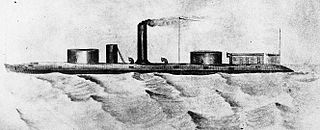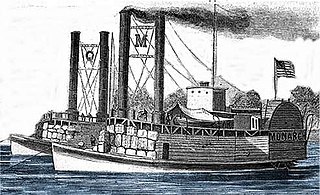The Union Iron Works (first known as Carondelet Marine Railway Company and later as Union Marine Works) was a shipbuilding and engineering firm in Carondelet, St. Louis, Missouri, United States.
It was founded in the 1850s by Primus Emerson as the Carondelet Marine Railway Company. It sat where Marceau Street, off South Broadway, met the Mississippi River. The yard had tracks and cranes that could haul ships in or out of the river using a railway car that descended into the water, mated with a ship's hull, and was hauled up the bank and into one of a handful of sheds. The yard employed 800 artisans, laborers and shipwrights. [1]
In 1861, riverboat salvager and engineer James Eads leased the yard and used it to build ironclads for the Union Navy during the American Civil War. In 1869 and 1870, facilities of the Union Iron Works were used by William Nelson and Co. to fabricate the caissons used to build Eads Bridge.

Mound City is a city located along the Ohio River just north of its confluence with the Mississippi River in Pulaski County, Illinois, United States. As of the 2010 census, the city population was 588. It is the county seat of Pulaski County.

Captain James Buchanan Eads was a world-renowned American civil engineer and inventor, holding more than 50 patents.

Union Iron Works, located in San Francisco, California, on the southeast waterfront, was a central business within the large industrial zone of Potrero Point, for four decades at the end of the nineteenth and beginning of the twentieth centuries.

USS Carondelet (1861) was a City-class ironclad gunboat constructed for the War Department by James B. Eads during the American Civil War. It was named for the town where it was built, Carondelet, Missouri.

Fore River Shipyard was a shipyard owned by General Dynamics Corporation located on Weymouth Fore River in Braintree and Quincy, Massachusetts. It began operations in 1883 in Braintree, and moved to its final location on Quincy Point in 1901. In 1913, it was purchased by Bethlehem Steel, and later transferred to Bethlehem Shipbuilding Corporation. It was sold to General Dynamics in 1963, and closed in 1986. During its operation, yardworkers constructed hundreds of ships, for both military and civilian clients.

USS Chickasaw was an ironclad Milwaukee-class river monitor built for the United States Navy during the American Civil War. The ship participated in the Battle of Mobile Bay in August 1864, during which she was lightly damaged, and the bombardments of Forts Gaines and Morgan as Union troops besieged the fortifications defending the bay. In March–April 1865, Chickasaw again supported Union forces during the Mobile Campaign as they attacked Confederate fortifications defending the city of Mobile, Alabama.

Carondelet is a neighborhood in the extreme southeastern portion of St. Louis, Missouri. It was incorporated as an independent city in 1851 and was annexed by the City of St. Louis in 1870. As of the 2000 Census, the neighborhood has a population of 9,960 people.

USS Winnebago was a double-turret Milwaukee-class river monitor, named for the Winnebago tribe of Siouan Indians, built for the Union Navy during the American Civil War. The ship participated in the Battle of Mobile Bay in 1864, during which she was lightly damaged, and the bombardments of Forts Gaines and Morgan as Union troops besieged the fortifications defending the bay. In early 1865, Winnebago again supported Union forces during the Mobile Campaign as they attacked Confederate fortifications defending the city of Mobile, Alabama. She was placed in reserve after the end of the war and sold in 1874.

USS Neosho, the lead ship of her class, was an ironclad river monitor laid down for the Union Navy in the summer of 1862 during the American Civil War. After completion in mid-1863, the ship spent time patrolling the Mississippi River against Confederate raids and ambushes as part of Rear Admiral David Porter's Mississippi Squadron. She participated in the Red River Campaign in March–May 1864. Neosho resumed her patrols on the Mississippi after the end of the campaign. She supported the Union Army's operations on the Cumberland River and provided fire support during the Battle of Nashville in December 1864. Neosho was decommissioned after the war and remained in reserve until sold in 1873.

USS Osage was a single-turreted Neosho-class monitor built for the Union Navy during the American Civil War. After completion in mid-1863, the ship patrolled the Mississippi River against Confederate raids and ambushes as part of Rear Admiral David Porter's Mississippi Squadron. Osage participated in the Red River Campaign in March–May 1864, during which she supported the capture of Fort DeRussy in March and participated in the Battle of Blair's Landing in April. The ship was grounded on a sandbar for six months after the end of the campaign and badly damaged. Osage, after being refloated and repaired, was transferred to the West Gulf Blockading Squadron in early 1865 for the campaign against Mobile, Alabama. During the Battle of Spanish Fort in March 1865 she struck a mine and rapidly sank. The ship was later salvaged and sold in 1867.

USS Ozark was a single-turreted river monitor built for the United States Navy during the American Civil War. The ship served in the Mississippi River Squadron during the war, and participated in the Red River Campaign shortly after she was commissioned in early 1864. Ozark patrolled the Mississippi River and its tributaries after the end of the campaign for the rest of the war. She was decommissioned after the war and sold in late 1865.
USS Kickapoo was a double-turreted Milwaukee-class river monitor, the lead ship of her class, built for the Union Navy during the American Civil War. The ship supported Union forces during the Mobile Campaign as they attacked Confederate fortifications defending the city of Mobile, Alabama in early 1865. She was placed in reserve after the end of the war and sold in 1874.
The first USS Milwaukee, a double-turreted Milwaukee-class river monitor, the lead ship of her class, built for the Union Navy during the American Civil War. The ship supported Union forces during the Mobile Campaign as they attacked Confederate fortifications defending the city of Mobile, Alabama in early 1865. She struck a mine in March and sank without loss. Her wreck was raised in 1868 and broken up for scrap that was used in the construction of a bridge in St. Louis, Missouri.

The Battle of Grand Gulf was fought on April 29, 1863, during the American Civil War. As part of Major General Ulysses S. Grant's Vicksburg campaign, seven Union Navy ironclad warships commanded by Admiral David Dixon Porter bombarded Confederate fortifications at Grand Gulf, Mississippi. One of the Confederate fortifications, named Fort Wade, was silenced, but the other, named Fort Cobun, continued firing. Due to the strong Confederate resistance, Grant and Porter decided it was not feasible to make an amphibious landing at Grand Gulf, but later landed at Bruinsburg, Mississippi, instead. After the Confederates were defeated at the Battle of Port Gibson on May 1, Grand Gulf was rendered indefensible and the fortifications were abandoned. The defenders of Grand Gulf then fought at the Battle of Champion Hill on May 16 and the Battle of Big Black River Bridge on May 17, before the start of the Siege of Vicksburg, which ended with a Confederate surrender on July 4. Today, the battlefield is preserved in Grand Gulf Military State Park, which was listed on the National Register of Historic Places in 1972.

USS Baron DeKalb (1861) was a City-class ironclad gunboat constructed for the Union Navy by James B. Eads during the American Civil War.

USS Monarch was a United States Army sidewheel ram that saw service in the American Civil War as part of the United States Ram Fleet and the Mississippi Marine Brigade. She operated on the Mississippi River and Yazoo River during 1862 and 1863.

The Pook Turtles, or City-class gunboats to use their semi-official name, were war vessels intended for service on the Mississippi River during the American Civil War. They were also sometimes referred to as "Eads gunboats." The labels are applied to seven vessels of uniform design built from the keel up in Carondelet, Missouri shipyards owned by James Buchanan Eads. Eads was a wealthy St. Louis industrialist who risked his fortune in support of the Union.
The Delaware River Iron Ship Building and Engine Works, was a major late-19th-century American shipyard located on the Delaware River in Chester, Pennsylvania. It was founded by the industrialist John Roach and is often referred to by its parent company name of John Roach & Sons, or just known as the Roach shipyard. For the first fifteen years of its existence, the shipyard was by far the largest and most productive in the United States, building more tonnage of ships than its next two major competitors combined, in addition to being the U.S. Navy's largest contractor. The yard specialized in the production of large passenger freighters, but built every kind of vessel from warships to cargo ships, oil tankers, ferries, barges, tugs and yachts.

The Neosho-class monitors were a pair of ironclad river monitors laid down in the summer of 1862. After completion in mid-1863, both ships spent time patrolling the Mississippi River against Confederate raids and ambushes as part of Rear Admiral David Porter's Mississippi Squadron. Both ships participated in the Red River Campaign in March–May 1864, although Osage supported the capture of Fort DeRussy in March and participated in the Battle of Blair's Landing in April. Osage was grounded on a sandbar for six months after the end of the campaign while Neosho resumed her patrols on the Mississippi. The latter ship supported the Union Army's operations on the Cumberland River and provided fire support during the Battle of Nashville in December.
The Milwaukee-class monitors were a class of four riverine ironclad monitors built during the American Civil War. Several supported Union forces along the Mississippi River in mid-1864 before participating in the Battle of Mobile Bay in August. Chickasaw and Winnebago bombarded Confederate coastal fortifications during the battle and during subsequent operations as well as engaging the ironclad Tennessee II. The other two ships arrived at Mobile Bay after the battle and all four supported the land attacks on Mobile in March–April 1865. Milwaukee struck a torpedo during this time and sank. The surviving three ships were sold in 1874; Chickasaw was converted into a ferry and survived until 1944 when she was scuttled. Her wreck was discovered in 2004.













